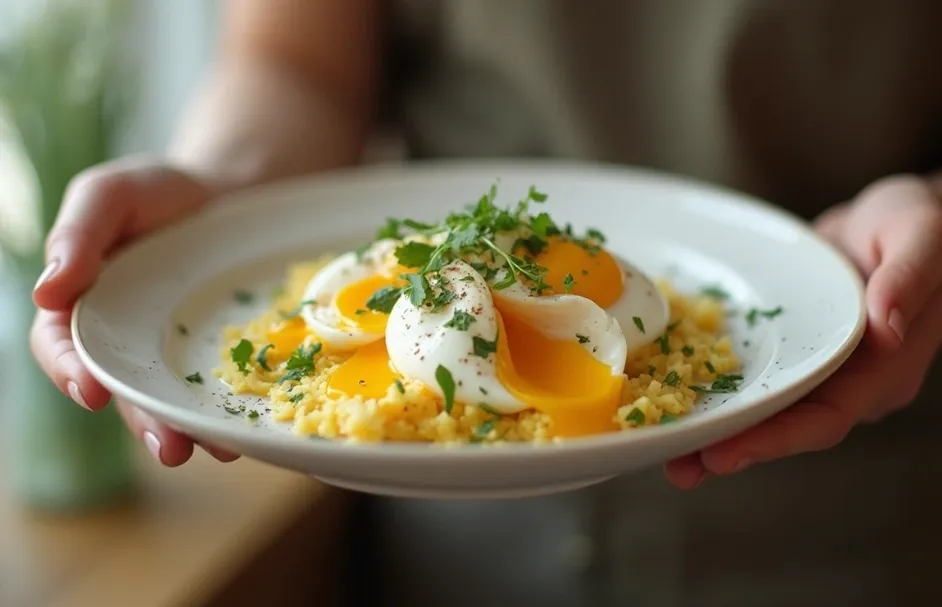
“Cooking is an art, but all art requires knowing something about the techniques and materials.”
Have you ever watched those cooking shows where chefs effortlessly create beautiful poached eggs with perfectly set whites and gloriously runny yolks? For years, I thought this culinary feat required professional training or special equipment. After countless attempts (and many disappointing results), I’ve finally mastered the art of poaching eggs. Today, I’m sharing my tried-and-true method that delivers restaurant-quality poached eggs every single time.
Why Poached Eggs Are Worth Mastering
Before diving into the technique, let’s talk about why poached eggs deserve a place in your cooking repertoire. A well-poached egg is:
- Lower in calories than fried eggs (no added fat needed)
- Versatile enough for breakfast, lunch, or dinner
- The perfect protein-rich topping for toast, salads, grain bowls, and more
- Impressively elegant when served to guests
The combination of tender whites and that luscious, flowing yolk creates a natural sauce that elevates virtually any dish it touches.
Common Poaching Problems (And How I Solved Them)
Through trial and error, I’ve identified the main challenges when poaching eggs:
- Whites spreading everywhere in the water
- Inconsistent cooking times leading to overcooked yolks
- Difficulty removing the eggs without breaking them
- Timing issues when making multiple eggs
Each of these problems has a simple solution, which I’ll address in my method below.
My Foolproof Poaching Technique
Essential Equipment
You don’t need fancy tools, but these basics will help:
- A wide, shallow pan (at least 3 inches deep)
- A slotted spoon
- Small cups or ramekins
- Fresh eggs (the fresher, the better!)
- White vinegar (regular distilled works perfectly)
- A timer
Step 1: Prepare Your Eggs
The freshest eggs produce the best results when poaching. As eggs age, their whites thin out and tend to disperse more in the water. Here’s how I start:
- Crack each egg into its own small cup or ramekin
- Check for shell fragments and remove if necessary
- Let eggs come to room temperature if time permits (about 15 minutes)
Step 2: Create the Perfect Poaching Environment
The water temperature and acidity are crucial factors in successful poaching:
- Fill your pan with about 3 inches of water
- Add 1 tablespoon of white vinegar per quart of water
- Heat the water until it reaches a gentle simmer (small bubbles appearing at the bottom of the pan)
- Reduce heat to maintain this temperature – it should be around 180°F (82°C)
Pro Tip: The vinegar helps the egg whites coagulate quickly, preventing them from spreading. Don’t worry – you won’t taste it in the finished egg!
Step 3: The Perfect Poach
Now for the exciting part – the actual poaching:
- Create a gentle whirlpool in the water by stirring in one direction with a spoon
- Holding your cup with the egg close to the water surface, gently slide the egg into the center of the whirlpool
- Let the egg cook undisturbed for 3 minutes for a runny yolk, 4 minutes for a medium yolk
- Use a slotted spoon to carefully lift the egg and check doneness – the whites should be set but the yolk still soft
Step 4: Remove and Serve
The final step requires a gentle touch:
- Use your slotted spoon to carefully lift the poached egg from the water
- Hold it over the pan for a few seconds to drain excess water
- Place on a paper towel-lined plate to absorb any remaining moisture
- Season with salt and freshly ground pepper
- Serve immediately on your prepared dish
Troubleshooting Tips for Perfect Poached Eggs
Even with the best technique, things can go wrong. Here’s how I handle common issues:
| Problem | Solution |
|---|---|
| Whites spreading too much | Use fresher eggs and/or add more vinegar to the water |
| Yolk breaking before cooking | Be extra gentle when transferring to water or try the plastic wrap method |
| Whites not setting properly | Water may be too cool – increase temperature slightly |
| Overcooked yolks | Reduce cooking time by 30-60 seconds |
| Difficulty timing multiple eggs | Poach one at a time and keep warm in a bowl of hot water |
Advanced Poaching Tips
Once you’ve mastered the basic poaching technique, try these advanced tips:
- Make ahead: Poached eggs can be made up to 24 hours in advance and stored in ice water in the refrigerator. To reheat, place in hot (not boiling) water for 30-60 seconds.
- The strainer method: For ultra-clean results, crack your egg into a fine mesh strainer first to drain off the thinnest part of the white before poaching.
- Poaching multiple eggs: For brunch crowds, poach eggs one at a time and keep them in warm water until serving.
Serving Suggestions
The beauty of poached eggs lies in their versatility. My favorite ways to serve them include:
- Classic Eggs Benedict with hollandaise sauce
- Atop avocado toast with red pepper flakes
- On a bed of sautéed greens with a splash of balsamic
- Crowning a bowl of ramen or soup
- With roasted vegetables and a drizzle of olive oil

Final Thoughts
Mastering the poaching technique has transformed my home cooking. What once seemed like restaurant-exclusive magic is now a quick, nutritious option in my kitchen any day of the week. With a little practice using this method, you’ll be creating picture-perfect poached eggs that would make any chef proud.
Remember, the key elements for perfect poached eggs are fresh eggs, gentle heat, a touch of vinegar, and patience. Follow these principles, and you’ll never struggle with poaching eggs again!
What’s your favorite way to enjoy poached eggs? I’d love to hear about your egg-poaching adventures in the comments below.
